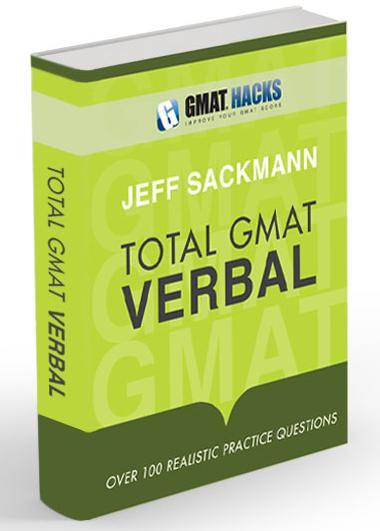
Bookshelf
|
|
Total GMAT Math Jeff's complete Quant guide, on sale now! |
|
|
Total GMAT Verbal Everything you need to ace GMAT Verbal! |
1,800 Practice Math Questions
Buy Jeff's books at Amazon.com

GMAT Official Guide, with IR
OG Math | OG Verbal
OG12 & Quant Rev solutions!
GMAT Question of the Day
Beginner's Guide to the GMAT
GMAT Hacks Affiliate Program

Recent Hacks

Categories
- General Study Tips
- Goals and Planning
- CAT Strategy
- The Mental Game
- GMAT Math Strategy
- GMAT Math Topics
- Mental Math
- Data Sufficiency
- Critical Reasoning
- Reading Comprehension
- Sentence Correction
- Analytical Writing Assessment
- Integrated Reasoning
- IR Explained
- Business School Admissions
- GMAT Prep Resources
- Practice Questions
- Total GMAT Math
- Total GMAT Verbal
- GMAT 111

The Three Steps to GMAT Success
| You should follow me on Twitter. While you're at it, take a moment to subscribe to GMAT Hacks via RSS or Email. |
Preparing for the GMAT can be complicated. Students rarely take a step back and take a big-picture view of how they are approaching the test. Many tutors and test-prep companies are guilty of the same mistake.
Let's take that step back. Here are the three components of a successful study plan for the GMAT:
- Understand the test.
- Master the fundamentals.
- Using realistic materials, practice perfectly.
That's it. Let's dig a little deeper.
Understand the Test
The GMAT is not like any other exam. In particular, it doesn't have very much in common with college tests, and there are plenty of important differences between the GMAT and other standardized tests like the SAT, ACT, LSAT, and GRE.
Before you can successfully approach the test, you need to know how the computer-adaptive mechanism functions. You need to be familiar with the length of the exam and the range of tested material. In particular, you need to thoroughly understand how Data Sufficiency questions work.
If you don't know how you'll be tested, it doesn't matter how well you know the material. It's like showing up at an event and giving an unrehearsed, impromptu speech while everyone else has practiced their speeches, word for word, for months.
Master the Fundamentals
The GMAT doesn't explicitly test fundamental knowledge, but if you don't have it, you won't excel on the test. For example, you need to hone your algebra and geometry skills to perfection; you must be able to analyze the structure of an essay; you need to be very familiar with the rules of English grammar.
Importantly, you need to establish these skills before you move on to the next step. Total GMAT Math was designed in part to fulfill this purpose; Total GMAT Verbal also fills in many of these gaps for the Verbal portion of the test.
While students obsess about topics like combinatorics and bold-face Critical Reasoning, most of them would be better off drilling fundamentals. I would guess that at least 90% of GMAT test-takers could improve their score simply by focusing on "basic" subject matter such as fundamental grammar rules and algebraic technique.
Using Realistic Material, Practice Perfectly
This last step is the simplest, though it will take up the most of your time.
First: Practice only with realistic material. I can't emphasize this enough. Use the Official Guide. Take the GMATPrep practice tests. If you need more, turn to my sets of practice problems. The average book you take off the shelf at Barnes and Noble just isn't good enough.
Next: Practice perfectly. I've written a longer article about how to do so. In short: Do fewer problems, but master them all.
If that means doing some questions over and over again, that's great. You're not finished with a question until you know how to do it, are confident in your approach, and can complete it in the correct amount of time for that question type.
This List is Short, but Exhaustive
If you're spending your GMAT-study time doing something that isn't on this list, you're wasting your time. Change your plan so that you are always focused on understanding the test, mastering fundamentals, or practice perfectly using realistic materials.
About the author: Jeff Sackmann has written many GMAT preparation books, including the popular Total GMAT Math, Total GMAT Verbal, and GMAT 111. He has also created explanations for problems in The Official Guide, as well as 1,800 practice GMAT math questions.
 |
Total GMAT Verbal
The comprehensive guide to the GMAT Verbal section. Recognize, dissect, and master every question type
you'll face on the test. Everything you need, all in one place, including 100+ realistic practice questions. |